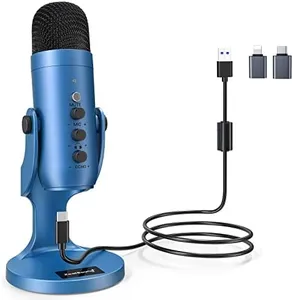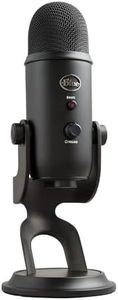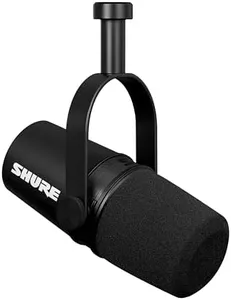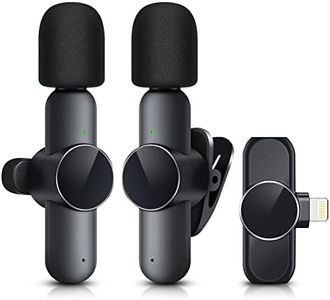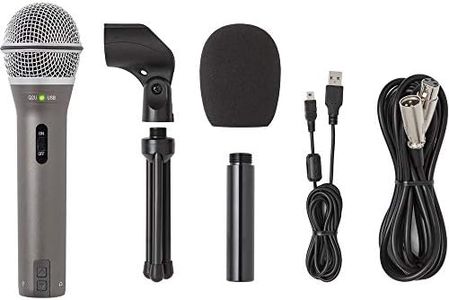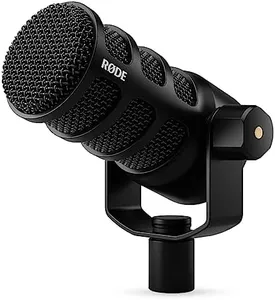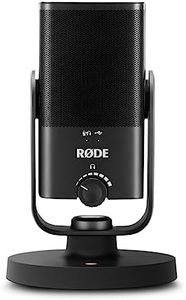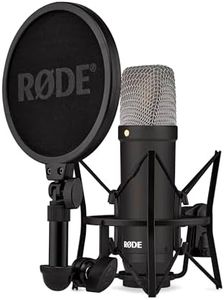10 Best Recording Microphones 2025 in Canada
Our technology thoroughly searches through the online shopping world, reviewing hundreds of sites. We then process and analyze this information, updating in real-time to bring you the latest top-rated products. This way, you always get the best and most current options available.

Our Top Picks
Winner
ZealSound USB Microphone,Condenser Gaming Mic for Phone/Laptop/PC/PS4/5/Computer,Microphone with Gain Knob,LED Mute,Monitor Volume Adjustment,Stand Base for Streaming, Podcast, Studio Recording (Blue)
The ZealSound USB Microphone is a condenser mic designed primarily for gaming, streaming, podcasting, and general content creation. It features a unidirectional (cardioid) polar pattern, which helps focus on your voice while reducing background noise—great if you record in less-than-ideal environments. The frequency response ranges from 40 Hz to 18,000 Hz, which covers the essential vocal range clearly but might miss some very low or high-end sounds compared to professional studio mics. With a sensitivity of 125 dB and a signal-to-noise ratio of 85 dB, it captures audio with decent clarity and relatively low background hiss, suitable for home use or casual streaming.
One of its highlights is the USB connectivity, including adapters for iPhone, iPad, and Type-C devices, making it very plug-and-play without needing extra audio equipment—ideal for users who want simplicity without sacrificing too much sound quality. It also offers handy onboard controls like a gain knob, volume adjustment, echo control, and a mute button with an LED indicator, which are very useful during live streams or meetings. The included adjustable metal stand and foam windscreen add value by providing stable placement and some wind noise reduction out of the box.
On the downside, since it is a USB condenser mic, it may not offer the same audio depth or versatility as higher-end XLR microphones used in professional studios. The frequency upper limit and sensitivity are good for typical voice work but might not satisfy users looking for ultra-high fidelity recording. Also, although it supports zero-latency headphone monitoring, the maximum frequency sample rate of 48 kHz is standard but not exceptional. This microphone suits beginners or intermediate users who want an easy setup for streaming, podcasting, or gaming across various devices without complex gear. It balances convenience and solid audio quality but falls short if you need professional studio-grade sound or advanced audio customization.
Logitech for Creators Blue Yeti USB Microphone for Gaming, Streaming, Podcasting, Twitch, YouTube, Discord, Recording for PC and Mac, 4 Polar Patterns, Studio Quality Sound, Plug & Play-Blackout
The Logitech Blue Yeti USB microphone is a versatile and popular option for gaming, streaming, podcasting, and general recording on PC and Mac. It uses a condenser tri-capsule array that captures clear, studio-quality sound, making it suitable for a wide range of uses from vocals to instruments. One of its standout features is the four switchable polar patterns—cardioid, omni, bidirectional, and stereo—giving users flexibility usually requiring multiple microphones. This helps with different recording setups like solo streaming, interviews, or group podcasts.
It connects via USB, which means it’s very easy to set up with plug-and-play functionality, no additional audio interface needed. This is great for beginners or anyone wanting hassle-free recording. The onboard controls for headphone volume, mic gain, pattern selection, and mute let you adjust your sound on the fly without extra software. The included Blue VO!CE software adds extra vocal effects and sound enhancements to improve the quality of your streams and recordings.
The frequency response from 20 Hz to 20 kHz covers the full range of human hearing, ensuring natural recorded audio. Sensitivity and signal-to-noise ratio are designed to capture detailed sound with minimal background hiss, though as a condenser mic, it is more sensitive to ambient noise than dynamic mics. The built-in adjustable stand helps position the mic easily for the best sound capture. While it relies solely on USB connectivity, making it incompatible with professional XLR setups without adapters, and its self-noise won’t match high-end studio microphones in extremely noise-sensitive environments, this Blue Yeti is a solid choice for creators looking for an all-in-one, easy-to-use microphone that covers multiple recording needs with good sound quality and flexible features, especially if you’re working primarily at a computer without complex audio gear.
Shure MV7X Microphone - XLR Only Pro Quality Dynamic Mic for Podcasting & Vocal Recording, Voice-Isolating Technology, All Metal Construction, Mic Stand Compatible, Optimized Frequency - Black
The Shure MV7X is a dynamic microphone designed especially for podcasting and vocal recording, offering professional quality at a reasonable price. It uses an XLR connection, which means it works best when paired with an audio interface or mixer, making it suitable for users who have or plan to get this additional equipment. Its unidirectional (cardioid) polar pattern helps focus on your voice while minimizing background noise, which is great if you record in less-than-ideal environments.
The microphone’s design is inspired by the classic SM7B, known for clear, warm vocal sound, so it’s reliable for spoken voice and singing. Built with all-metal construction, the MV7X is durable and fits standard microphone stands easily, adding to its convenience. It does not offer USB connectivity, so it’s not a plug-and-play option for beginners without audio gear.
If you want a straightforward, sturdy microphone focused on voice with professional XLR output, the MV7X represents a smart choice, particularly for multi-microphone setups on a budget.
